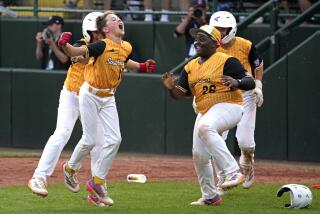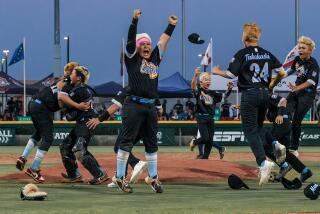Formula Used to Break Ties Is Still a Work in Progress
- Share via
WILLIAMSPORT, Pa. — Since the single-elimination format was eliminated in 1991, Little League organizers have attempted to fine- tune the tiebreaking formula that decides which teams advance to the U.S. and International championship games.
And each year there has been criticism.
If anything it was a bit more confusing this year, even when Little League officials tried to explain it.
As pool play started Thursday morning all four U.S. teams had a chance to advance to the championship game, even Dyer, Ind., which had yet to win a game.
The tiebreaker formula says that in case of a three-way tie for first place among the four teams involved, “the total number of runs given up divided by defensive innings played by that team would be used to advance one team.”
The rules go on to say that the second team to advance will be determined by who won in head-to-head competition.
So here’s the scenario South Mission Viejo Coach Jim Gattis faced when he put his team on the field before its 3-0 victory over Pottsville, Pa.:
If Pottsville won and gave up eight or fewer runs, it would have had a rematch with South Mission Viejo in the U.S. title game. If Pottsville had won, but gave up nine or more runs, Pottsville would have played Bradenton, Fla., to which it lost, 5-0, in 10 innings Tuesday.
The West won, so it faced the South, which it defeated, 10-6, Tuesday.
Gattis questioned the logic of the tiebreaker.
“That’s the first time I have ever coached where I could lose, 10-0, and still go to a championship,” he said.
Little League spokesman Lance Van Auken said the association continues to review the system, but believes it is on the right track. This is the second year this method has been in place and here’s the reason the current formula is used, according to Van Auken:
“The first couple of years we broke a tie by allowing the team with the least number of runs to go,” he said. “When we did that, it was hard to justify sending the second team if it had a better run differential when a team that doesn’t defeats the team that does.”
*
Forget the can shakers. Those plastic water bottle substitutes created by South Mission Viejo fans on the spur of the moment are all the rage.
Fans of the Saudi Arabian team showed up with about two dozen shakers for their game at 8:30 a.m. Thursday. They lost to Yokohama (Japan) Seya, 2-1, and were eliminated from international play.
The handful of Japanese fans here have been waving and chanting for their team with fans with the words “Seya” on the blade. But for the championship game they were spotted with about two dozen of their own penny-shakers.
The Saudis, as a show of good sportsmanship, returned with their penny shakers to root for Mexico, which has a very small following.
South Mission Viejo created the shakers using aluminum beverage cans, but were turned away at the gate of Lamade Stadium when Little League security officials cited safety concerns. They quickly scavenged through trash cans for plastic water bottles and created the new wrinkle in what has become a fan favorite at this series.
*
Add shakers: The truth can now be told. Not everyone from Mission Viejo likes them.
“That sound drives the dads crazy,” Michael Nieves, father of reserve outfielder Andrew Nieves, said. “We went up to the store across from the field and bought portable radios. We listen to the broadcast of the game rather than the noise those things make.”
*
The announced attendance for South Mission Viejo’s 3-0 victory over Pottsville was 15,200, well off the 35,600 who watched Pottsville lose to Bradenton on Tuesday night. Pottsville is 59 miles south east of Williamsport and the rivalry between the townships stretches back years. Their township high schools compete in the Pennsylvania Eastern Conference, so it’s no big deal for fans to make the journey to the Little League headquarters.
“Those Pottsville people will just bring the entire town,” said usher Gary Spies, a longtime Williamsport resident who put four children through school here. “They play Williamsport in every sport and they really support their town.”
*
Baseball players are superstitious. So when Southern California Manager Jim Gattis won the toss for Thursday’s U.S. final, he chose to take the third base dugout and bat first.
All three victories in pool play came with South Mission Viejo leading off, as did the 2-1 Western Region victory over Sunnyvale.
*
Several South Mission Viejo players have a peculiar habit. After every pitch, they field a pretend ground ball and throw out a pretend runner. The phony plays are intended to keep players’ thoughts on the game.
“We believe the game begins with the feet,” Gattis said. “So some of them do that.”
It must work. The team did not commit an error in three pool-play victories.
(BEGIN TEXT OF INFOBOX / INFOGRAPHIC)
Local Legacy
Orange County teams that have advanced to the Little League World Series and the results:
1968
Bolsa (Santa Ana) reached semifinals, losing to eventual champion Japan, 3-0.
1987
Northwood (Irvine) reached the series championship game, losing to Taiwan, 21-1.
1990
Cypress reached the semifinals, losing to Shippensburg, Pa., 5-4.
1995
Yorba Hills (Yorba Linda) reached the U.S. championship game, losing to Spring, Texas, 5-2.


